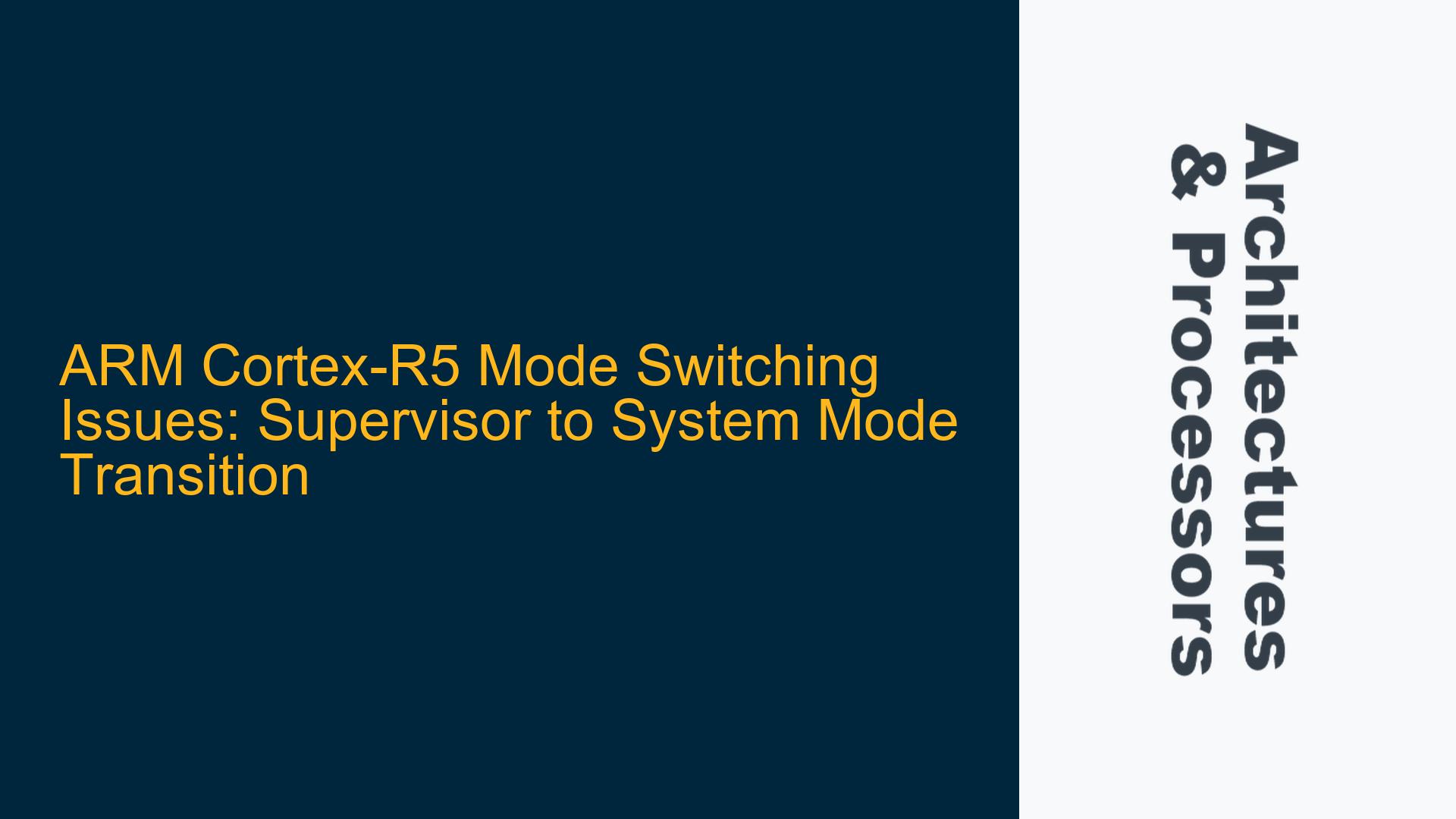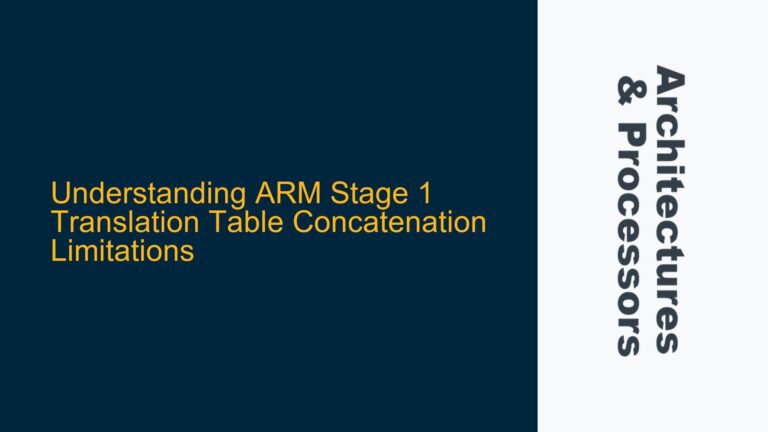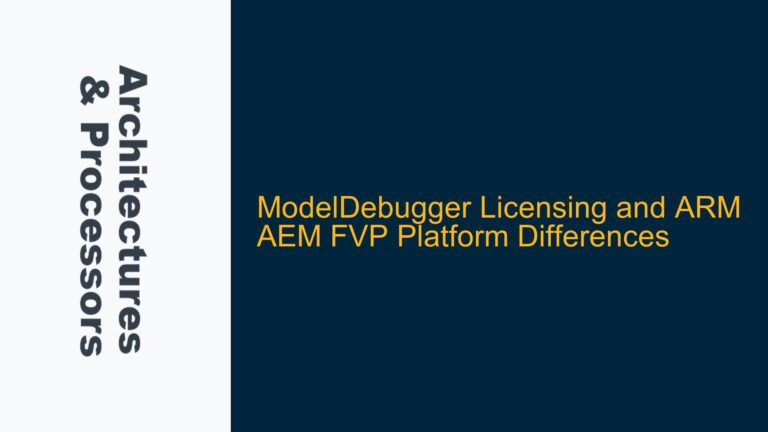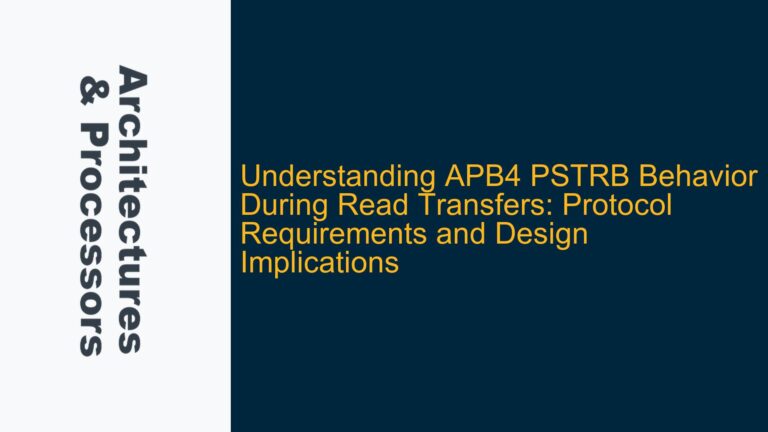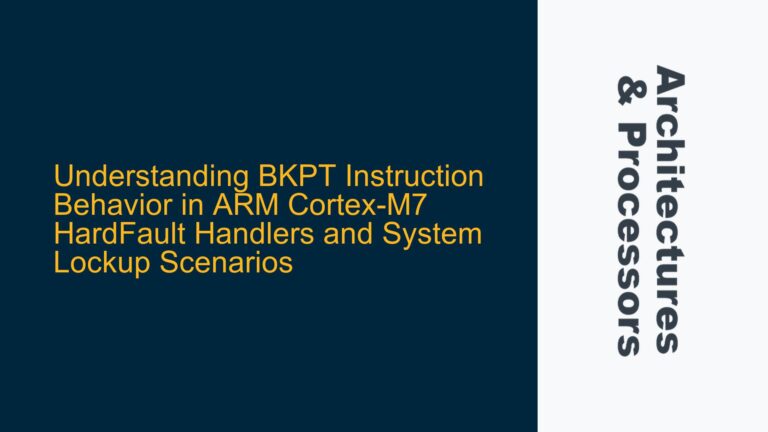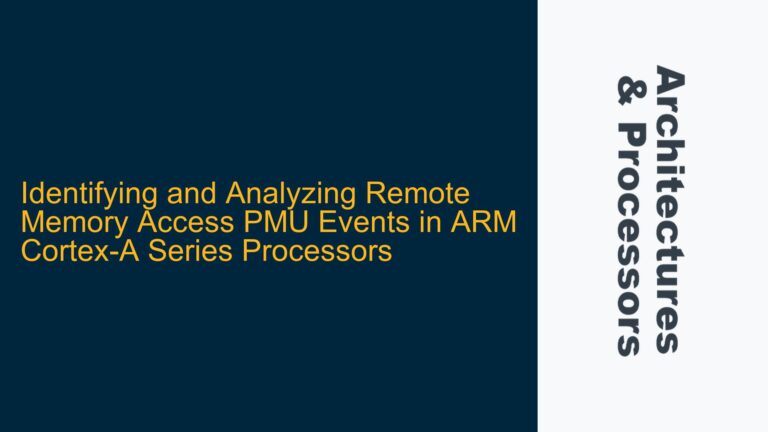Understanding the Cortex-R5 Mode Switching Challenge
The ARM Cortex-R5 processor, like many ARM cores, operates in multiple privilege modes to ensure secure and efficient execution of tasks. One common challenge developers face is transitioning between these modes, particularly from Supervisor mode (0x13) to System mode (0x1F). This transition is often required in embedded systems where an RTOS (Real-Time Operating System) is used, and the scheduler needs to operate in System mode while the application runs in User mode. However, improper handling of this transition can lead to system resets, corrupted stack pointers (SP), and link registers (LR), rendering the system unstable.
The Cortex-R5 processor’s mode switching mechanism is tightly coupled with the Current Program Status Register (CPSR). The CPSR controls the processor’s state, including the current mode, interrupt flags, and condition codes. When switching modes, the processor banks in new SP and LR registers specific to the target mode. If these registers are not properly managed, the system can inadvertently branch to an invalid address, triggering a reset or other undefined behavior.
In the context of an RTOS, the scheduler typically requires privileged access to manage tasks, interrupts, and system resources. However, the application tasks should run in User mode to ensure isolation and security. This necessitates a clear understanding of how to safely transition between modes without disrupting the system’s operation.
Root Causes of Mode Switching Failures
The primary issue when switching from Supervisor mode to System mode on the Cortex-R5 stems from the banking of SP and LR registers. When the processor changes modes, it automatically banks in the SP and LR registers associated with the new mode. If these registers are not initialized or preserved correctly, the system can enter an unstable state. Below are the key factors contributing to mode switching failures:
1. Uninitialized System Mode Stack Pointer (SP)
- When transitioning to System mode, the processor banks in the SP register specific to System mode. If this register is not initialized, the stack operations (e.g., PUSH, POP) will use an invalid memory address, leading to a crash or reset.
- In the discussed scenario, the SP register in System mode was observed to be 0x00000000 after the mode switch, indicating that it was not properly set up before the transition.
2. Corrupted Link Register (LR)
- The LR register is used to store the return address for function calls. When switching modes, the LR register is also banked. If the LR is not preserved or restored correctly, the
BX LRinstruction will branch to an invalid address, often the reset vector (0x00000000), causing a system reset. - In the provided example, the LR register in System mode was cleared to 0x00000000 after the mode switch, leading to an unintended branch to the reset vector.
3. Improper Handling of Privilege Levels
- Both Supervisor and System modes are privileged modes, but they serve different purposes. Supervisor mode is typically used for handling exceptions and running the RTOS kernel, while System mode is used for running privileged application code. Switching between these modes requires careful management of privilege levels to ensure that the RTOS and application tasks do not interfere with each other.
- The RTOS scheduler may fail to initialize if the mode switch is not handled correctly, as it relies on specific privilege levels to manage tasks and resources.
4. Lack of Synchronization Between Modes
- When switching modes, it is essential to ensure that the processor state is consistent across both modes. This includes preserving the SP and LR registers, as well as ensuring that the CPSR is updated correctly. Failure to synchronize these states can result in unpredictable behavior, such as system resets or crashes.
Resolving Mode Switching Issues: Best Practices and Solutions
To address the challenges of switching from Supervisor mode to System mode on the Cortex-R5, the following steps and solutions are recommended:
1. Preserving and Restoring SP and LR Registers
-
Before switching modes, the current SP and LR registers must be preserved. This can be done by pushing these registers onto the stack in Supervisor mode and then restoring them after switching to System mode.
-
The following assembly code demonstrates how to safely switch modes while preserving the SP and LR registers:
_CPU_system_mode_Switch: PUSH {R0, R1, LR} // Preserve R0, R1, and LR on the Supervisor stack MOV R1, SP // Copy the current SP (Supervisor mode) into R1 MRS R0, CPSR // Read the CPSR into R0 ORR R0, R0, #0x1F // Set the mode bits to System mode (0x1F) MSR CPSR, R0 // Switch to System mode MOV SP, R1 // Copy the preserved SP (from R1) into the System mode SP POP {R0, R1, PC} // Restore R0, R1, and return using the preserved LR -
This code ensures that the SP and LR registers are preserved across the mode switch, preventing the system from branching to an invalid address or using an uninitialized stack.
2. Initializing System Mode Stack Pointer
-
Before switching to System mode, the SP register for System mode should be initialized to a valid memory region. This can be done during the system initialization phase, before any mode switches occur.
-
For example, during the startup code, the System mode SP can be set as follows:
LDR SP, =System_Stack_Top // Initialize System mode SP to the top of the System stack -
This ensures that the System mode stack is ready for use when the mode switch occurs.
3. Avoiding Function Calls During Mode Switching
- Mode switching should ideally be performed inline rather than as a function call. This avoids the need to preserve and restore the LR register, reducing the risk of branching to an invalid address.
- If a function call is necessary, the LR register must be explicitly managed, as shown in the previous code example.
4. Ensuring Proper Privilege Level Management
-
The RTOS scheduler should run in Supervisor mode, while application tasks run in User mode. System mode can be used for privileged application code, but care must be taken to ensure that the RTOS and application tasks do not interfere with each other.
-
The following table summarizes the recommended privilege levels for different components:
Component Recommended Mode Purpose RTOS Kernel Supervisor (0x13) Managing tasks, interrupts, and resources Application Tasks User (0x10) Running application code Privileged App Code System (0x1F) Running privileged application code
5. Debugging Mode Switching Issues
- When debugging mode switching issues, it is essential to use a debugger to step through the code and inspect the CPSR, SP, and LR registers before and after the mode switch.
- The following steps can help identify and resolve issues:
- Verify that the CPSR is updated correctly during the mode switch.
- Check that the SP and LR registers are preserved and restored as expected.
- Ensure that the System mode SP is initialized to a valid memory region.
- Confirm that the mode switch does not inadvertently branch to the reset vector or another invalid address.
6. Handling Mode Switching in RTOS Context
- In an RTOS environment, mode switching should be tightly integrated with the scheduler and task management system. The RTOS should handle mode transitions when switching between tasks, ensuring that the correct privilege level is maintained for each task.
- For example, when a task is scheduled to run, the RTOS can switch to User mode before executing the task. When the task yields or is preempted, the RTOS can switch back to Supervisor mode to manage the next task.
7. Testing and Validation
- After implementing the mode switching logic, thorough testing is essential to ensure that the system operates correctly under all conditions. This includes testing mode transitions during normal operation, exception handling, and task switching.
- Automated tests can be developed to validate the mode switching logic, including edge cases such as nested mode switches and concurrent mode transitions.
Conclusion
Switching between Supervisor mode and System mode on the ARM Cortex-R5 processor requires careful management of the CPSR, SP, and LR registers. By preserving and restoring these registers, initializing the System mode stack, and ensuring proper privilege level management, developers can avoid system resets and other instability issues. The provided solutions and best practices offer a robust framework for handling mode transitions in embedded systems, particularly in RTOS environments. With thorough testing and debugging, developers can ensure that their systems operate reliably and efficiently across different privilege modes.
